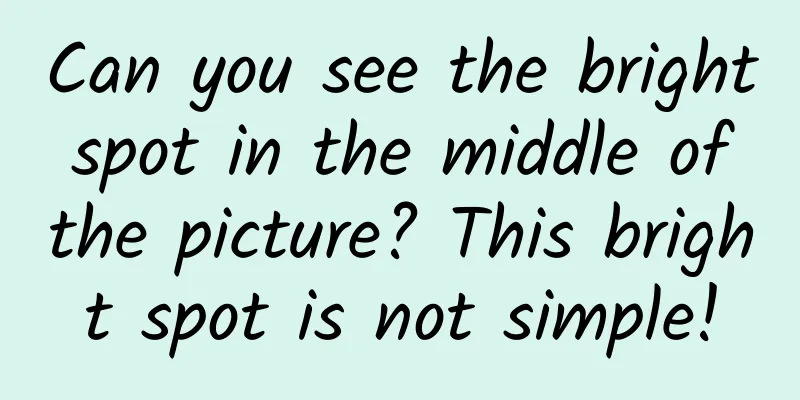Can you see the bright spot in the middle of the picture? This bright spot is not simple!

|
As we all know, the Eiffel Tower is the most famous landmark building in Paris, France. Tourists traveling to Paris usually visit this place, but few people pay attention to the 72 names engraved on the tower. These names are carved on the four walls of the first platform of the Eiffel Tower. Each letter is more than half a meter high. They are all French physicists, chemists, mathematicians, engineers and outstanding figures in other fields, and Augustin Fresnel is one of them. Fresnel Fresnel was born in Broglier, Eure, France, into an architect's family in 1788. He was sickly since childhood and received enlightenment education from his mother at home. Much like Einstein, Fresnel did not show his genius when he was young. Instead, he was a little slow in learning and had difficulties in reading until he was eight years old. But at the age of nine, he seemed to suddenly come to his senses and began to show his talent in science and technology, independently making toy bows and toy guns. In 1804, Fresnel was admitted to the École Polytechnique in Paris with excellent grades. While at school, he was still frail and sickly, but he studied diligently and still achieved excellent results, especially in painting and geometry. After graduating in 1806, Fresnel entered the French National School of Bridges and Roads for further studies. After graduation, he became an engineer, mainly engaged in road construction. In 1815, Napoleon was restored to the throne. Fresnel, who opposed Napoleon, was persecuted, dismissed from his post and imprisoned. After the Battle of Waterloo, Napoleon was defeated and exiled for the second time. The Hundred Days' Reign ended, and the Bourbon dynasty was restored again. Fresnel regained his freedom. It was during these months of imprisonment that Fresnel began several optical studies, among which the study of diffraction even triggered an optical revolution. Fresnel had only conducted research in his spare time before, but this imprisonment allowed him to devote himself to optics. During this period, he also wrote a paper on stellar aberration. Although this paper was not published, it was also an important achievement in his work and laid the foundation for his further research in the future. In 1818, when the Second Wave-Particle War was in full swing, the French Academy of Sciences held a prize essay competition. The title of the competition was "Use precise experiments to determine the diffraction effect of light and deduce the movement of light when it passes near an object." The competition jury was composed of many famous scientists, such as Laplace, Poisson, Biot who supported the particle theory and Arago who supported the wave theory. This essay competition also became an important battlefield in the second wave-particle war. In 1819, the unknown young engineer Fresnel, encouraged by physicists Arago and Ampere, submitted a paper to the essay competition committee. The core of this paper is the theory that later became known as the Huygens-Fresnel principle. Huygens' principle means that every point on the wave surface is a wave source that emits sub-waves, and the envelope of these sub-waves is a new wavefront. Huygens' principle can well explain the phenomena of rectilinear propagation, reflection, and refraction of light, and can also qualitatively explain the cause of diffraction. However, its defects are also obvious: first, it is impossible to quantitatively calculate the intensity distribution of the diffraction wave; second, according to the theory, there will be retrograde waves, which is obviously inconsistent with reality. Based on Huygens' principle, Fresnel gave a quantitative description of the amplitude and phase of the sub-wave, and at the same time introduced the concept of coherent superposition - the vibration of any point in space is the result of the coherent superposition of all sub-waves at that point. The final theory formed is the famous Huygens-Fresnel principle. Fresnel's paper expounding this theory was rigorous and flawless in its derivation, which impressed many judges. However, Poisson, a judge who firmly believed in the particle theory, did not agree with this theory. He reviewed the paper very carefully and used the theory in the paper to perform calculations. When this theory was applied to the diffraction of a circular disk, a bright spot appeared in the center of the shadow. This calculation result was contrary to people's intuition. Poisson also thought this was absurd, so he used this calculation result to question Fresnel's paper. The bright spot in the center of the disk diffraction shadow was indeed a bit unbelievable, and this question almost prevented Fresnel's paper from passing the review committee. Fortunately, the judge Arago, who supported the wave theory, insisted on conducting experimental verification. The experimental results showed that there was indeed a bright spot in the center of the disk diffraction shadow, and its position and brightness perfectly matched the theoretical calculation results. Fresnel's theory won. The bright spot calculated by Poisson was originally used to question Fresnel's diffraction theory, but in the end it became strong evidence to support this theory. The bright spot in the center of the disk diffraction shadow was later misleadingly called the Poisson bright spot, which added to the drama of the event. Poisson bright spot In the same year, Fresnel also invented the Fresnel lens. Compared with the original lens, the Fresnel lens has equal curvature at all corresponding locations and can still play the role of a lens, but its focal length is shorter. This design uses less material than ordinary lenses, is smaller in size, thinner in lens, can transmit more light, and is also easy to build lenses with larger apertures. It was first used in lighthouses and is also widely used in production and life, such as car headlights, mobile phone flashlights, and aircraft carrier Fresnel optical landing aid systems. Fresnel lens Fresnel's theory based on wave theory explained the diffraction phenomenon well and dealt a heavy blow to the particle theory of light, but it could not explain the polarization phenomenon of light well. To this end, Fresnel revolutionized the hypothesis that light is a transverse wave, and together with Arago mentioned above, he studied the interference of polarized light. In 1821, he published a paper, "On the Interaction of Polarized Light", which successfully explained the polarization phenomenon using transverse wave theory. Fresnel also discovered and explained circularly polarized light and elliptically polarized light; derived the famous Fresnel formula; and explained the phenomena of double refraction and polarization of reflected light. In 1823, Fresnel was elected a member of the French Academy of Sciences, and in 1825 he was elected a member of the Royal Society of London. He died of tuberculosis in 1827 at the age of 39. Long-term illness did not defeat Fresnel. He continued to climb the scientific peak tirelessly, made outstanding contributions in diffraction and polarization, and was later hailed as the "founder of physical optics." 【References】 1Book: University Physics Volume 2, authors Xu Sannan, Lu Jian, Xu Pu, published by Machinery Industry Press in August 2005. 2 Books: Does God Play Dice? A History of Quantum Mechanics, author Cao Tianyuan, Liaoning Education Press, January 2006. 【Scientist Profile】 Augustin Fresnel (May 10, 1788 - July 14, 1827) was a famous French physicist and one of the main founders of the theory of wave optics. Tadpole Musical Notation original article/reprint please indicate the source Editor/Xiao Xitushuo |
<<: Can we genetically modify pests to make them 're-insects'?
>>: Mosquito warning! I love people wearing these four colors the most
Recommend
All kinds of bizarre biological lamps, the earth's "original" lighting technology!
In modern society, electric lights are generally ...
How to plan an e-commerce promotion strategy?
How to plan this kind of big promotion campaign? ...
MIR DATABANK: Review of China's industrial robot market in the first three quarters of 2020 and annual forecast
According to MIR DATABANK data, the year-on-year g...
SOP for live broadcast room with monthly sales of one million
Today I will share with you a very important modu...
She lived a hundred years, leaving behind spirit and legend
A sad news came Qu Duyi, winner of the "July...
Is it prostate cancer as soon as it is discovered? Men have these minor symptoms, indicating that there may be something wrong with the prostate
Going to the toilet more often and urinating more...
【Cold Wind】Rent an account to play the box v1.0_Non-toxic software
I see there are a lot of people needing it recent...
Unexpectedly! This place on earth is the best place to see the stars
"Sitting on the ground, I can travel eighty ...
New research comes out! Who lives longer, fast or slow walkers?
In 2019, the Mayo Clinic Journal in the United St...
Apple releases first public beta of OS X Yosemite 10.10.5
[[140925]] Apple recently released OS X 10.10.5 b...
How to improve the product experience in response to user operational errors?
Editor's note: Users may inevitably make mist...
Comfortable! WeChat new version update: support mobile phone, iPad, PC terminal simultaneous login
[[411307]] Today, WeChat iOS version ushered in a...
How to do marketing on Women’s Day? Here are 4 tips for you!
Today is International Women's Day... NO, you...
Fingerprint recognition is faster than iPhone: Meizu MX4 Pro unboxing and hands-on
Although there was the MX4 before and the Meizu B...
Tik Tok operation planning program for real estate industry!
1. Industry Background As we all know, in the tra...









